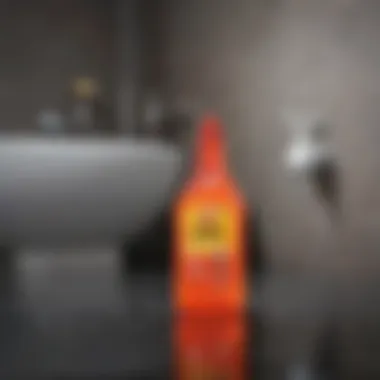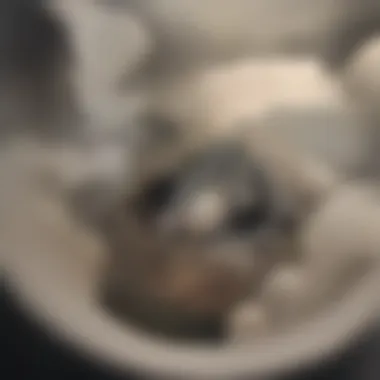Unclog Toilet Drain Cleaner: Your Ultimate Guide


Intro
Clogs in toilets are common issues that homeowners must face. This guide delves into the world of drain cleaners, specifically designed for unclogging toilets. Knowing the capabilities and limitations of these products is essential for effective toilet maintenance. It is crucial to consider the various types of drain cleaners available in the market today and how they work to ensure their safe and effective use.
Preventative measures also play a significant role in maintaining toilet functionality. Understanding how to avoid clogs before they occur save both time and money. This article aims to provide a detailed insight into toilet unclogging methods, safety guidance, and preventative maintenance strategies. It serves as a resource for those seeking to improve their home plumbing knowledge without sacrificing style or beauty.
"Toilet maintenance goes beyond simple fixes; it includes understanding the tools at your disposal and how to use them wisely."
To create an inviting yet functional space, one must understand the relationship between aesthetics and practical solutions like drain cleaners. Through careful exploration, readers will gain valuable insights that empower them to handle toilet issues confidently.
Understanding Toilet Drain Clogs
Toilet drain clogs are a common household issue that can lead to significant inconvenience if not addressed promptly. In this article, understanding these clogs becomes essential. Clogs not only affect the daily use of a toilet, but they may also signal larger plumbing problems. Knowing what causes these blockages and how to identify them bolsters effective maintenance practices. This knowledge is crucial for home maintenance enthusiasts and those keen on preserving their home's functionality.
Common Causes of Toilet Clogs
Several factors contribute to toilet clogs, and awareness of these can help avert them. Here are some common causes:
- Excessive Toilet Paper: Using too much toilet paper at once can create a mass that the drain cannot handle.
- Non-flushable Items: Items such as wipes, feminine products, or any objects not meant to be flushed can obstruct the drain.
- Mineral Buildup: Hard water can lead to mineral deposits in pipes, narrowing the flow and causing backups.
- Tree Roots: In some cases, tree roots can invade and obstruct sewer lines, leading to more severe plumbing issues.
Each of these scenarios can contribute to a buildup that stops wastewater from flowing, making prevention and awareness key.
Signs of a Clogged Toilet
Recognizing the signs of a clogged toilet early can save homeowners time and money. Common indicators include:
- Slow Draining: If water drains slowly or not at all, it might signal a blockage.
- Gurgling Sounds: Unusual sounds from the toilet can indicate air being trapped by a clog.
- Water Backup: Overflowing toilets require immediate attention and often indicate a serious clog.
- Foul Odors: Bad smells emanating from the toilet can be a sign of waste buildup.
Understanding these signs can empower homeowners to act quickly, potentially avoiding more complicated and costly repairs.
Exploring Different Types of Drain Cleaners
Understanding the various types of drain cleaners is crucial for maintaining a functional and hygienic bathroom. Each type of drain cleaner has its own set of ingredients, mechanisms, and effectiveness levels. This section discusses the main categories of drain cleaners available, showcasing their unique benefits and considerations to help readers make informed decisions when addressing toilet clogs.
Chemical Drain Cleaners
Chemical drain cleaners usually contain strong substances that can break down clogs quickly. The most common ingredients in these cleaners include sodium hydroxide and sulfuric acid.
- Speed: They often provide instant results, dissolving hair, soap, grease, and other blockages within minutes.
- Effectiveness: Chemical cleaners are usually effective against tough clogs that other methods might not resolve.
However, users should be cautious. These chemicals can pose several risks:
- Health risks: Exposure can lead to skin burns, respiratory issues, or eye damage.
- Environmental impact: They can cause harm to local ecosystems when flushed away.
Proper use and safety precautions are essential to mitigate these risks. Always follow the manufacturer's instructions and consider protective gear such as gloves and goggles.
Enzymatic Drain Cleaners
Enzymatic drain cleaners offer a different approach. They use natural enzymes and bacteria to break down organic material. This method is often more gentle than its chemical counterpart.


- Sustainability: They are usually safer for the environment, causing no harm to plumbing systems or waterways.
- Long-term effectiveness: By continuing to break down organic matter over time, they help prevent future clogs, promoting ongoing system health.
On the flip side, enzymatic cleaners may require a longer time to work. Users should be patient, as results may not be immediate.
Natural Alternatives
Natural alternatives include household items like baking soda and vinegar. This approach is particularly appealing for those seeking eco-friendly solutions.
- Availability: Many people already have these ingredients at home, eliminating the need for store-bought cleaners.
- Cost-effective: They are typically much cheaper than chemical or enzymatic options.
While natural remedies can be effective for minor clogs, they might not work for severe blockages. It is best to assess the clog's severity before relying solely on natural solutions.
In summary, choosing the right drain cleaner depends on various factors including the severity of the clog, the potential risks, and personal preferences regarding environmental impact. Understanding these different types is an essential step in maintaining toilet functionality.
How Chemical Drain Cleaners Work
Understanding how chemical drain cleaners function is essential for anyone looking to resolve toilet clogs efficiently. This section will delve into the active ingredients and their mechanism of action, offering insights into the effectiveness and nuances of these cleaning solutions.
Active Ingredients
Chemical drain cleaners typically contain powerful active ingredients designed to break down blockages. Some of the common components include:
- Sodium Hydroxide: Often known as lye, this caustic substance can dissolve organic materials, such as hair and grease. It reacts with water to generate heat, intensifying its cleaning action.
- Sodium Hypochlorite: This is bleach, and although primarily known as a disinfectant, it helps in breaking down certain types of clogs.
- Sulfuric Acid: Extremely effective for heavy clogs, this acid reacts violently with water and can open up blocked pipes rapidly.
- Enzymatic Agents: Enzymatic drain cleaners contain bacteria or enzymes that digest organic waste. They work slower than chemical alternatives but are often viewed as safer for pipes.
These ingredients are selected based on their capacity to address specific types of clogs. Knowing these substances can also aid in selecting the right product.
Mechanism of Action
The effectiveness of chemical drain cleaners hinges on their unique mechanisms of action. When applied to a clogged toilet, these cleaners generally follow this process:
- Application: The cleaner is poured into the toilet bowl, where it contacts the blockage.
- Reaction: Depending on the ingredients, a reaction occurs. For example, sodium hydroxide heats up and dissolves debris, while sulfuric acid effectively breaks down tough clogs.
- Clearing the Blockage: With the blockage being broken down, water flow is restored as the debris is either dissolved or dislodged.
"Chemical drain cleaners can provide immediate relief from stubborn clogs, saving time when compared to physical methods."
However, using these cleaners does come with considerations. Always ensure proper ventilation, follow usage instructions carefully, and be aware of any harmful fumes generated during the reactions. Understanding how these cleaners work will guide users in their selection process, ensuring an optimized approach to unclogging toilets.
Evaluating the Effectiveness of Drain Cleaners
Evaluating the effectiveness of drain cleaners is a vital component of understanding how to maintain a functional toilet. This section emphasizes that not all drain cleaners perform equally, and users must discern which products will yield the best results for their specific clog situations. By analyzing the effectiveness of various options, one can make an informed choice that aligns with individual needs and preferences. Gaining insights from this evaluation helps ensure not only successful unclogging but also minimizes potential damage to the plumbing system.
Factors Influencing Effectiveness
The effectiveness of a drain cleaner depends on a variety of factors. These elements can significantly affect how well a product works in clearing a clog. The following are key considerations:
- Type of Clog: Different materials cause different clogs. A buildup of hair may respond well to one cleaner, while mineral deposits might require another.
- Drain Cleaner Composition: The active ingredients in the cleaner play a crucial role. Chemical cleaners often have stronger agents, while enzymatic or natural options may take longer to work but are generally safer for pipes.
- Time of Application: Leaving the cleaner in the drain for the recommended time is essential. Some products require several minutes to several hours to dissolve the clog effectively.
- Temperature of Water: Warm water can enhance the effectiveness of some drain cleaners, particularly those that rely on heat.
- Drain Condition: Old or corroded pipes may not respond well to aggressive cleaners and may require gentler alternatives.
Considering these factors helps consumers choose the right cleaner for their specific situation, improving the chance of successful unclogging.
Comparison of Different Types
When comparing the different types of drain cleaners available, it becomes clear that each has its different strengths and weaknesses. Each type caters to specific needs of homeowners.


- Chemical Drain Cleaners: These are typically potent and designed to dissolve tough clogs quickly. However, they can be harsh on pipes and pose health risks. Users must exercise caution.
- Enzymatic Drain Cleaners: These use natural enzymes to break down organic material. While they are safer for pipes, they often require more time to work and may not be as effective for severe clogs.
- Natural Alternatives: Products like vinegar and baking soda offer a mild and environmentally friendly method to combat minor clogs. They are less effective on significant blockages but present a safe option for ongoing maintenance.
Understanding the differences between these cleaners is crucial. Homeowners can then decide which method aligns best with their goals and values. The knowledge of how each type works allows for more strategic decisions in maintaining a clear and functional toilet.
Safety Considerations When Using Drain Cleaners
Understanding the safety considerations when using drain cleaners is crucial to ensure not only the efficiency of unclogging a toilet but also the well-being of users and the environment. Many drain cleaners on the market contain potent chemicals designed to dissolve clogs effectively. However, these substances can pose significant health risks and environmental threats if not handled properly. The right knowledge and precautions can help mitigate these dangers, making the process safer for everyone involved.
Health Risks
When it comes to health, certain chemicals in drain cleaners can be hazardous. Materials like sodium hydroxide or sulfuric acid are common in chemical drain cleaners. These elements can cause skin burns, respiratory issues, and eye damage upon contact or inhalation.
Always wear gloves and goggles when handling these products.
Symptoms of exposure can vary. In some cases, coughing, choking, or irritation may occur if inhaled. If the cleaner comes into contact with skin, it can lead to painful burns.
To avoid these risks:
- Store drain cleaners out of the reach of children.
- Avoid mixing different brands together; doing so can create toxic gases.
- Use in a well-ventilated area to reduce inhalation risks.
Having sufficient safety equipment, such as masks and protective eyewear, is important too. Reading and understanding label instructions can further reduce the likelihood of accidents.
Environmental Impact
The environmental implications of using chemical drain cleaners can be equally alarming. Many of these substances can harm aquatic life and compromise water quality if they reach local waterways through drainage systems. Some chemicals do not break down easily, persisting in the environment and potentially entering drinking water supplies.
In addition to harming wildlife, these cleaners often contribute to the overall pollution load in sewer systems. Alternative cleaning methods, like enzymatic or natural drain cleaners, present safer options that offer fewer risks to both health and the environment. It is essential to consider:
- The type of chemicals being used.
- The method of disposal of any unused product.
Consumers should always dispose of these substances according to local regulations to limit environmental hazards.
By emphasizing safety in handling drain cleaners, incorporating knowledge about health risks and environmental impact, individuals can ensure both effective and responsible plumbing maintenance.
Alternative Methods for Unclogging Toilets
Unclogging toilets can often feel like an overwhelming task. However, there are several effective alternative methods to chemical drain cleaners that can help restore functionality without resorting to harsh substances. These methods are not only practical but can also mitigate the risks associated with chemical runoff and toxicity, making them suitable for various household situations. It’s important to understand the tools, techniques, and benefits of these methods to determine their effectiveness in different scenarios.
Plunging Techniques
Plunging is one of the most common methods for dealing with toilet clogs. It requires the use of a plunger, which consists of a rubber suction cup attached to a wooden or plastic handle. Here are some important tips for effective plunging:
- Choose the Right Plunger: A flange plunger is ideal for toilets. It has an extended rubber flap that provides a better seal compared to a regular cup plunger.
- Ensure Proper Seal: Place the plunger over the drain hole and push down to create a tight seal. This prevents air from escaping and maximizes suction.
- Use Correct Motion: Push down firmly and pull up quickly, repeating this motion several times. Maintain a steady rhythm to build suction, which can effectively dislodge the clog.
Key considerations include ensuring that there is enough water in the bowl to cover the plunger to create adequate suction. If the toilet is overflowed, it is advisable to remove some water before plunging to prevent further mess.
Using a Toilet Auger
A toilet auger, also known as a plumbing snake, is another useful tool for unclogging toilets. Unlike plungers, augers can navigate through the curves of the toilet traps. Here’s how to properly use one:
- Insert the Auger: Carefully insert the end of the auger into the toilet bowl until it reaches the clog.
- Crank the Handle: Gradually turn the handle, allowing the auger to extend through the blockage. This action can break up solid clogs or pull them out.
- Retrieve and Clean: Once you’ve cleared the clog, slowly retract the auger while cranking. Dispose of any debris collected on the auger and clean the tool appropriately.


This method is essential for addressing clogs that are too stubborn for plunging alone. It is vital to handle the auger with care to avoid damaging the porcelain of the toilet.
Baking Soda and Vinegar Method
A more natural approach involves using baking soda and vinegar. This method takes advantage of a chemical reaction that can break down clogs. Here’s how to use it:
- Pour Baking Soda: Start by pouring about one cup of baking soda directly into the toilet bowl. Allow it to settle for a few minutes.
- Add Vinegar: Next, add approximately one cup of vinegar. The combination will fizz and bubble, which can help dislodge debris.
- Wait and Flush: Let the mixture sit for at least 30 minutes, or even overnight if possible. Then, flush the toilet to see if the clog is gone.
Both baking soda and vinegar are environmentally friendly. This method can also help to deodorize the toilet and prevent future clogs when used regularly.
Using alternative unclogging methods can save money and reduce the impact of harsh chemicals on the environment.
Preventative Measures to Avoid Clogs
Preventative measures are crucial for maintaining the functionality of a toilet and avoiding the inconvenience of clogs. A proactive approach can save time, effort, and money. It is about integrating simple habits into daily routines that help maintain a healthy plumbing system.
One critical element lies in understanding the importance of not overloading the toilet. Flushing inappropriate items, such as paper towels, feminine hygiene products, or non-biodegradable materials can easily lead to blockages. Furthermore, educating household members about what is safe to flush should be part of any preventative strategy.
Regular Maintenance
Regular maintenance is integral to avoiding toilet clogs. By scheduling periodic checks, homeowners can catch early signs of issues. This might include inspecting the toilet for leaks, ensuring the flapper valve operates correctly, and testing the flush mechanism. Additionally, cleaning the toilet's internal parts can prevent build-up from mineral deposits.
- Clean the tank regularly: This helps prevent rust and mineral deposit build-up.
- Inspect rubber sealing and gaskets: Replacing worn parts can prevent leaks and inefficiencies.
- Check for slow leaks: A simple dye test with food coloring can reveal issues in the flapper that may need attention.
Performing these tasks every few months is beneficial. Taking time for maintenance not only prolongs the life of the toilet but also enhances functionality.
Best Practices for Toilet Use
Employing best practices for toilet use can dramatically reduce the likelihood of clogs. Encourage all users to flush only when necessary and avoid excessive flushing for small amounts of waste. Also, using moderate amounts of toilet paper is advisable. Large quantities of paper can easily overwhelm the plumbing system.
Another practice is to be mindful of water usage. Adequate water flow is necessary for a proper flush. A toilet that does not use enough water due to a faulty mechanism may not clear waste effectively. Therefore, checking for proper water levels in the tank is essential.
- Consider using a toilet brush: Keeping the bowl clean can prevent the build-up of debris.
- Implement a routine check before leaving home: Ensure that nothing is left floating in the toilet.
- Educate children: Teaching kids about proper toilet etiquette can prevent accidents and clogs.
Ultimately, these preventative measures create a more efficient system, encouraging proper function. They help homeowners avoid unpleasant consequences stemming from clogs, ensuring the toilet remains a reliable fixture in the home.
"An ounce of prevention is worth a pound of cure."
By prioritizing diligence and awareness, even the most common plumbing problems can become less of a burden.
Ending
The discussion of toilet drain cleaners is a vital aspect of maintaining the plumbing systems in our homes. A well-functioning toilet is often taken for granted until a clog disrupts the routine. Understanding the implications of various cleaning methods can help homeowners make informed decisions that benefit not only their immediate environment but also their long-term health and safety.
Recap of Key Points
In this article, we have explored several critical elements related to unclogging toilets:
- The common causes of toilet clogs and how recognizing signs can lead to prompt action.
- Different types of drain cleaners, including chemical and natural alternatives, each with their unique mechanisms and effectiveness.
- Safety considerations that highlight the potential risks to health and the environment.
- Alternative methods for unclogging toilets, illustrating that there are ways to address the problem without relying solely on chemical solutions.
- Preventative measures that can be employed to maintain optimal toilet function and minimize the occurrence of clogs.
Final Recommendations
When faced with a clogged toilet, it is essential to first evaluate the situation methodically. Opt for a plunger or toilet auger as a primary means of addressing minor clogs. For persistent issues, consider the appropriate use of drain cleaners while remaining aware of potential health risks. Always prioritize safety by adhering to the manufacturer’s instructions and using protective gear.
In addition, regular maintenance routines can significantly deter challenges posed by toilet clogs. This includes monitoring toilet usage and avoiding the disposal of non-biodegradable items. Also, consider natural alternatives such as baking soda and vinegar for periodic cleaning, as these can be effective without the environmental impact associated with chemical drain cleaners.
Ultimately, keeping your toilet in good working order requires a combination of understanding, proactive measures, and thoughtful application of cleaning methods. With this guide, homeowners can achieve a balance between functionality and safety, ensuring a clean, unclogged toilet.















